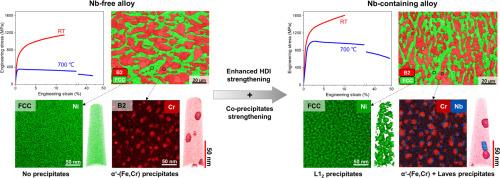通过纳米共析出和异质结构工程实现双相高熵合金优异的高温力学性能
IF 8.3
1区 材料科学
Q1 MATERIALS SCIENCE, MULTIDISCIPLINARY
引用次数: 0
摘要
共晶高熵合金(EHEAs)具有良好的室温力学性能,但高温强度有限。本文报道了一种通过纳米共沉淀和异质结构工程显著提高EHEAs室温和高温力学性能的新方法。我们发现,在Al-Co-Cr-Fe-Ni EHEA中加入Nb不仅可以在FCC相中析出L12纳米沉淀物,还可以在B2相中诱导α′和Laves纳米沉淀物的共析出,形成层次化异质结构。L12、α′和Laves纳米相的析出强化和异质变形诱导强化使合金的室温屈服强度达到1076 MPa, 700℃屈服强度达到905 MPa,同时在此温度范围内仍保持10% ~ 50%的高塑性。用第一性原理计算方法计算了FCC和B2相的本禀能量,结果表明,这两种相都可以通过位错滑移机制来适应塑性变形。两相的位错相互作用和异质变形引起的强化导致合金在室温下出现较大的应变硬化。在700℃时,原子迁移率的提高促进了可变形的B2相和FCC相中位错的移动,并且变形还引起晶界滑动和动态再结晶,这两者共同显著提高了合金的高温延展性。纳米级共沉淀和异质结构工程策略可以应用于其他材料,以获得优异的力学性能。本文章由计算机程序翻译,如有差异,请以英文原文为准。


Achieving excellent elevated-temperature mechanical properties in dual-phase high-entropy alloys via nanoscale co-precipitation and heterostructure engineering
Eutectic high-entropy alloys (EHEAs) have favorable mechanical properties at room temperature but limited strength at elevated temperatures. Here we report a novel approach to remarkably enhance both room- and elevated-temperature mechanical properties of EHEAs via nanoscale co-precipitation and heterostructure engineering. We found that the addition of Nb to an Al–Co–Cr–Fe–Ni EHEA not only triggers the precipitation of L12 nanoprecipitates in the FCC phase but also induces the co-precipitation of α' and Laves nanoprecipitates in the B2 phase, resulting in the formation of a hierarchical heterostructure. The precipitation strengthening from the L12, α', and Laves nanoprecipitates and the hetero-deformation induced strengthening elevate the yield strength to 1076 MPa at room temperature and 905 MPa at 700 °C while maintaining a high ductility of 10%–50% in this temperature range. First-principles calculations were used to evaluate the intrinsic energetics of the multicomponent FCC and B2 phases, and the results reveal that both phases can accommodate plastic deformation via a dislocation slip mechanism. The dislocation interactions in the two phases and the hetero-deformation induced strengthening contribute to the large strain hardening of the alloy at room temperature. At 700 °C, the increased atomic mobility facilitates the movement of dislocations in the deformable B2 and FCC phases, and the deformation also induces grain boundary sliding and dynamic recrystallization, which together substantially enhance the alloy ductility at elevated temperatures. The strategy of nanoscale co-precipitation and heterostructure engineering can be applied to other materials for achieving excellent mechanical properties.
求助全文
通过发布文献求助,成功后即可免费获取论文全文。
去求助
来源期刊

Acta Materialia
工程技术-材料科学:综合
CiteScore
16.10
自引率
8.50%
发文量
801
审稿时长
53 days
期刊介绍:
Acta Materialia serves as a platform for publishing full-length, original papers and commissioned overviews that contribute to a profound understanding of the correlation between the processing, structure, and properties of inorganic materials. The journal seeks papers with high impact potential or those that significantly propel the field forward. The scope includes the atomic and molecular arrangements, chemical and electronic structures, and microstructure of materials, focusing on their mechanical or functional behavior across all length scales, including nanostructures.
 求助内容:
求助内容: 应助结果提醒方式:
应助结果提醒方式:


